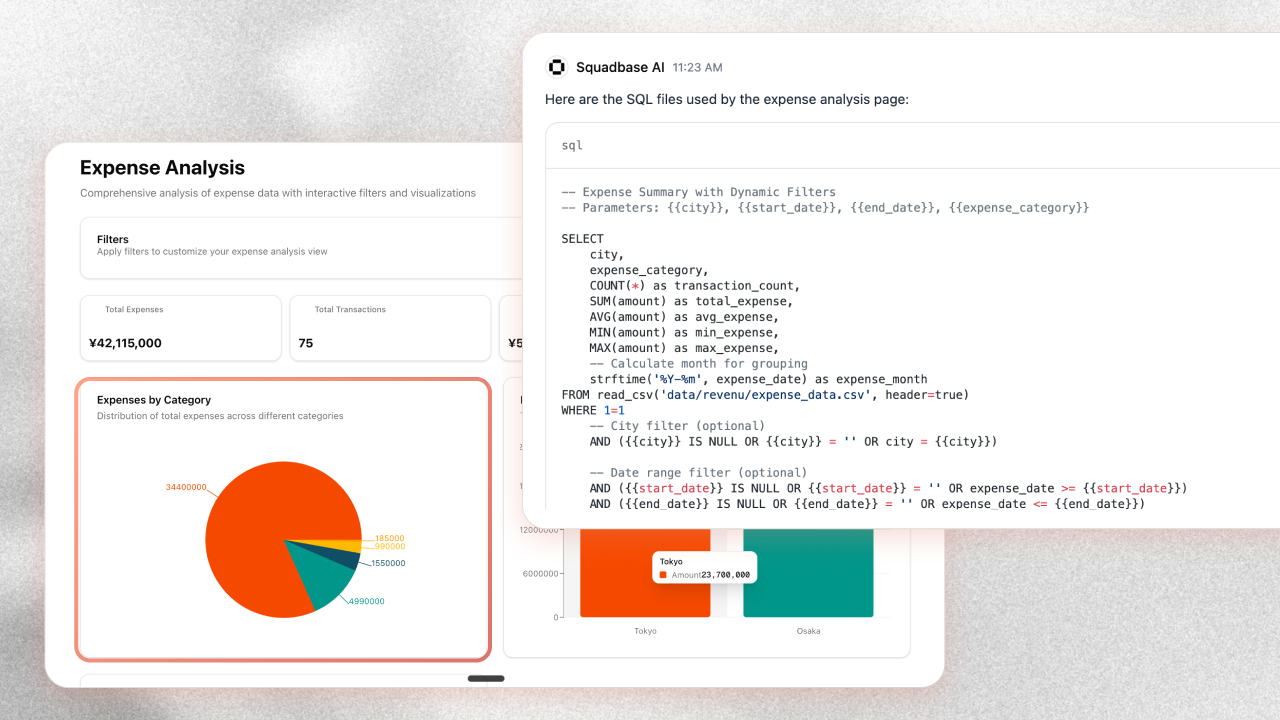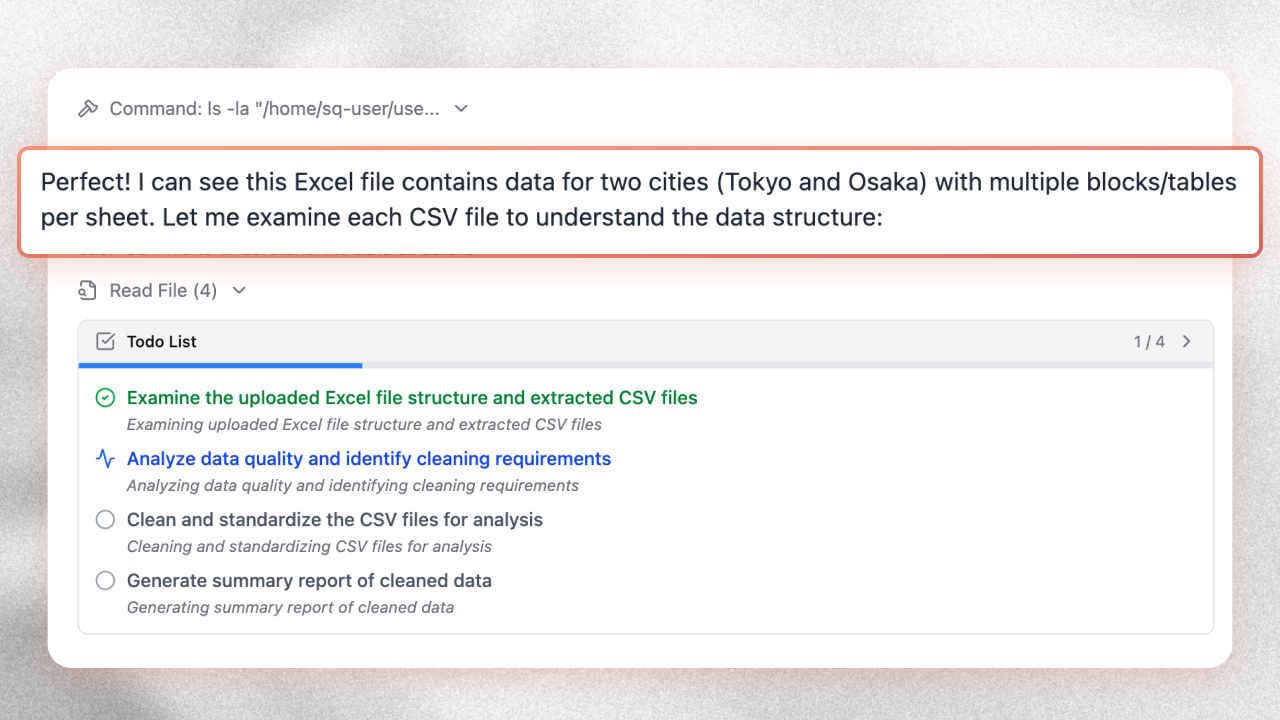Vibe Coding for Business Intelligence

Prologue
Here’s a surprising fact: the now-famous “Vibe Coding” tweet was posted in early February 2025. That’s right—less than a year ago. Yet the concept has already gone mainstream at an incredible pace.
Leading vibe-coding tools like Replit and Lovable are growing explosively. New challengers such as Rocket.new and Solid are rising fast too. At the same time, skeptics question whether vibe coding is just a fad. Some say it’s a playground for hobbyists, or that it’s too insecure for serious use.
So, is vibe coding just another hype cycle? Or perhaps a small arena where only a few startups will survive the battle?
We don’t think so. In fact, we believe vibe coding will transform far more of the work humans do with computers. Just as engineers have achieved 10x—or even 100x—productivity gains through vibe coding, we aim to bring that same revolution to Business Intelligence (BI).
Vibe Coding as a Paradigm Shift
Traditionally, building software required learning programming languages, understanding design patterns, and wrestling with bugs. But with large language models (LLMs), a new method has emerged: generating code through natural language conversation.
Many interpret this as a leap toward “anyone can build anything.” But that’s not quite right. Just as we haven’t yet achieved AGI that can solve every problem, we don’t yet have a coding AI that can build any software perfectly. In other words, without a clear goal, a vibe-coding tool cannot optimize its accuracy. Each tool has its own domain of strength.
When given a well-defined purpose, vibe-coding tools can rewrite the old software paradigm.
People now use Lovable instead of Webflow or Wix to build websites and web apps. They use Replit instead of Airtable or Glide to create micro-apps. And they use Superblocks instead of Retool or PowerApps to build internal tools.
This evolution shows how vibe coding is branching into the “democratization of creation.” But one domain—the enterprise world, and especially Business Intelligence (BI)—has been left behind. BI is where democratization is needed most, yet it’s also where optimization and innovation have lagged the furthest.
The Current State of BI: The Trap of Seeing
Modern companies rely on advanced BI tools such as Tableau, Power BI, and Looker. Yet in many organizations, dashboards get built but never used. Data is visible, but decisions don’t change. “Seeing” has become the goal, while decision-making—the true purpose—has been neglected.
Three problems lie behind this.
1) High Learning Cost
Legacy BI tools handle complex data pipelines through layers of abstraction—custom SQL dialects, intricate GUI configurations, and more.
To operate these abstractions, users must bear the burden of learning the tool itself. Those who manage to climb this steep learning curve become heroes of the organization—but also bottlenecks, as every request flows through them.
2) Inflexibility in Updating
Traditional BI emphasizes the static correctness of finished dashboards. To update an analysis, you must go upstream and modify every data transformation along the way. This structure creates rigidity—dashboards are hard to change, so people avoid touching them.
But business challenges are never static. The moment you view a dashboard and gain an insight, a new question emerges.
3) Licensing and Cost Structure
Legacy BI tools often charge not just for creators but also for viewers. That may seem reasonable, but it creates a deeper problem.
A small number of trained creators must justify the cost and relevance of dashboards for a much larger group of passive viewers. When those creators leave, dashboards decay—and the remaining viewers, separated by steep learning barriers, can do nothing. They keep paying simply for the right to look, regardless of whether the dashboard still adds value.
These frustrations have led many to hope that AI might finally deliver a solution.
Why Vibe Coding Is the Right Approach for BI
Vibe coding empowers everyone to create. Applied to BI, this has transformative implications.
1) A World Without Steep Learning Curves or Tool Constraints
Vibe coding eliminates the hard learning curve that has long defined BI. The boundary between creator and viewer disappears. Everyone can contribute to their organization through data, shifting from a world of delegation and silos to one of collaboration and shared insight.
Simply adding AI control on top of old BI tools doesn’t solve the real issue—the tools themselves remain the constraint. The provider still dictates what’s possible. In contrast, vibe coding lets AI write code from scratch, enabling true flexibility. You can now perform analyses or build data flows that were previously impossible.
2) Always-Up-to-Date, No More Waiting
Dashboards used to freeze after creation, with every update requiring scarce engineering time. With vibe coding, analysis becomes conversational.
Sales teams can dig deeper into numbers instantly. Marketing teams can pivot KPIs on the fly. There’s no waiting for a BI engineer. BI evolves from static reports to living, conversational analysis.
3) From Buying Viewing Rights to Building Capabilities
As everyone joins in analysis, viewers turn into creators. Problems discovered on the front line can be turned into insights immediately. Data use becomes a company-wide capability, not a specialist’s privilege. BI shifts from being a cost center to a learning ground that strengthens an organization’s ability to improve.
4) Accumulating Knowledge as a Shared Asset
In vibe coding, every analysis and visualization is stored as code. Past work can be reused or improved by AI, so analytical knowledge naturally compounds as an organizational asset. Reporting doesn’t end after one delivery; every iteration becomes training data for smarter future analyses. The whole organization evolves through data.
Optimizing Vibe Coding for Business Intelligence
Some of our users once tried to build dashboards in Lovable or Replit—and gave up. That’s because BI requires a tool purpose-built for it. Three optimizations are critical.
1) Security
Vibe-coding tools can expose risks like leaked credentials or missing access controls. For BI, a secure execution environment with strict access management and audit logs must be built in by default.
2) Transparency and Reliability in Analysis

In BI, the greater risk is not security—but trust. When AI writes the code, users may lose visibility into how results were produced. Even engineers might not know what’s happening behind the scenes.
That’s why BI-focused vibe-coding tools must make every step of data extraction and analysis transparent. Users need visibility into SQL, and AI should help explain and clarify the code itself.
3) Long-Term Memory of Data Schema and Domain Knowledge
Simply connecting AI to a data source won’t produce the perfect dashboard. An AI might infer that order_id refers to a customer order, but it won’t know what that means in your business context. A true BI coding agent must learn with the user, exploring data together, understanding its meaning, and remembering it for future analyses.

Squadbase: The Vibe Coding Platform for Business Intelligence
Squadbase is a vibe-coding platform built specifically for BI. It combines secure infrastructure, governance, analytical transparency, and BI-tuned coding agents into one unified environment.
The first step in using Squadbase for Vibe Coding in BI is simple: upload an Excel file and generate your first dashboard. If you already have a spreadsheet to analyze, you can instantly turn it into an interactive dashboard and share it with your team.
Viewers are free. That means you can spread the power of vibe-coded data analysis throughout your organization immediately.
Within fifteen minutes, your colleagues will be looking at your first creation.


